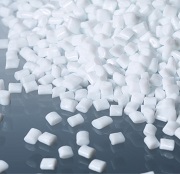Polyethylene terephthalate (abbreviated PET) is derived from the esterification of ethylene glycol with terephthalic acid. PET is a ubiquitous thermoplastic polymer, which finds application in multiple consumption sectors and products (e.g., packaging, textiles, film, etc.). Various countries have a well-developed PET-recycling system, supported by extensive legislation and responsible behaviour change patterns, which guarantee a high level of PET recycling (e.g., Denmark recycles up to 96% of its plastic bottles). In addition, companies worldwide, especially those interested in the development of their brands as symbols of sustainability, are interested in increasing the amount of recycled PET (R-PET) in their products or packaging. This constitutes the sustainability-driven megatrend, which makes polyethylene terephthalate a material of preference as compared to other polymers. In 2022, the global PET market volume exceeded 24 mln mty.
Unsurprisingly, the PET market encounters a range of serious challenges, especially in the current unstable macroeconomic environment, driven by rising energy prices, some signs of possible economic recession, anticipated weaker demand in several consumption sectors (e.g., carpet and textile sectors in 2023), and political unrest. However, the dynamic complexity of the global and regional polyethylene terephthalate markets has always been evident. For instance, M&G Chemicals’ large-scale project in Corpus Christi (the US) to boost PET output has never come to fruition after the company filed for bankruptcy when its project went heavily over budget in 2018. Likewise, in 2019, Oman International Petrochemical Industries Company’s (OMPET) PTA/PET project, planned to be located within the Sohar Industrial Port in Oman, has been canceled after its investors pulled from the project.
Polyethylene terephthalate: structure of the global production by region, 2022

There is a constrained supply of R-PET, which is likely to persevere in the nearest future. This shortage of recycled PET has recently boosted PET imports from Asia Pacific (this region accounts for the largest share of the global PET production. The market has been characterised by the oversupply of non-recycled PET for a prolonged period. The present regulatory regime concerning PET recycling is often viewed as complex and entangled. Currently, there is a call to revise the adopted EU legislation on packaging and packaging waste. The revision of this regulation has been recently proposed and caused concerns among multiple companies over the possible need to incur additional expenses and engage in further sacrifice. However, despite this development and turbulent market environment, the fundamentals of the global PET market remain robust.
A detailed analysis of the global PET market can be found in the in-demand research report “Polyethylene Terephthalate (PET): 2023 World Market Outlook and Forecast up to 2032”.
